bonnet Citroen DS5 2013.5 1.G Owner's Manual
[x] Cancel search | Manufacturer: CITROEN, Model Year: 2013.5, Model line: DS5, Model: Citroen DS5 2013.5 1.GPages: 372, PDF Size: 32.58 MB
Page 7 of 372

009009010010011011CHECKS TECHNICAL DATA AUDIO and
TELEMATICS
237 Opening the bonnet
238 Petrol engines
239 Diesel engines
240 Running out of fuel (Diesel)
241 Checking levels
245 Checks250 Petrol engines
251 Petrol weights
253 Diesel engines
255 Diesel weights
259 Dimensions
260 Identifi cation markings264 Emergency or assistance
267 eMyWay
323 Audio system
Page 16 of 372
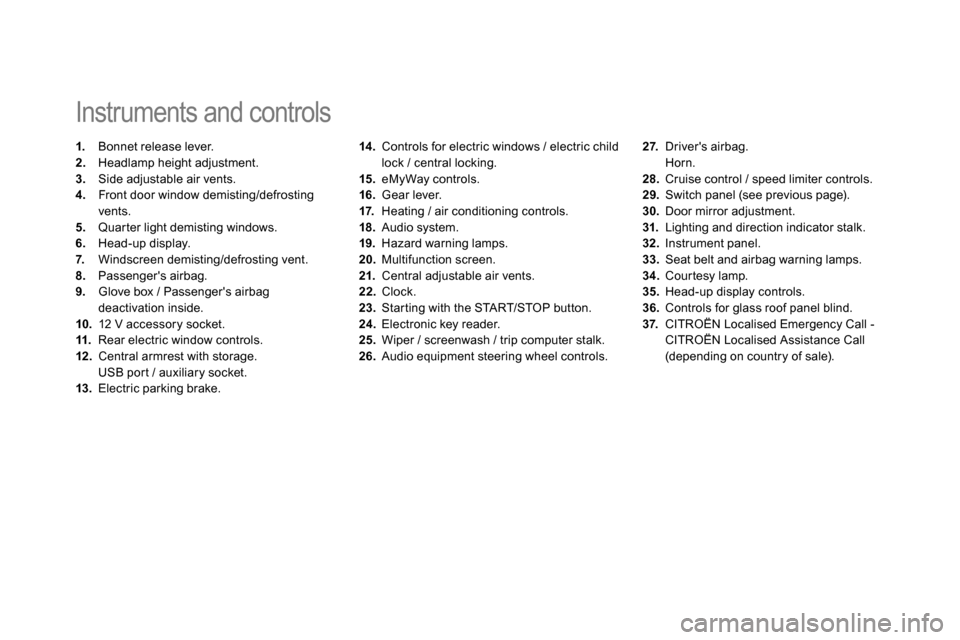
14 .
Controls for electric windows / electric child
lock / central locking.
15.
eMyWay controls.
16.
Gear lever.
17.
Heating / air conditioning controls.
18.
Audio system.
19.
Hazard warning lamps.
20.
Multifunction screen.
21.
Central adjustable air vents.
22.
Clock.
23.
Starting with the START/STOP button.
24.
Electronic key reader.
25.
Wiper / screenwash / trip computer stalk.
26.
Audio equipment steering wheel controls.
Instruments and controls
1.
Bonnet release lever.
2.
Headlamp height adjustment.
3.
Side adjustable air vents.
4.
Front door window demisting/defrosting
vents.
5.
Quarter light demisting windows.
6.
Head-up display.
7.
Windscreen demisting/defrosting vent.
8.
Passenger's airbag.
9.
Glove box / Passenger's airbag
deactivation inside.
10.
12 V accessory socket.
11.
Rear electric window controls.
12 .
Central armrest with storage.
USB port / auxiliary socket.
13.
Electric parking brake.
27.
Driver's airbag.
Horn.
28.
Cruise control / speed limiter controls.
29.
Switch panel (see previous page).
30.
Door mirror adjustment.
31.
Lighting and direction indicator stalk .
32.
Instrument panel.
33.
Seat belt and airbag warning lamps.
34.
Courtesy lamp.
35.
Head-up display controls.
36.
Controls for glass roof panel blind.
37.
CITROËN Localised Emergency Call -
CITROËN Localised Assistance Call
(depending on country of sale).
Page 26 of 372

127
128 128
Driving safely
Stop & Start
Going into engine STOP mode
The "ECO"
warning lamp comes on
in the instrument panel and the engine
goes into standby automatically:
Going into engine START mode
Deactivation / Reactivation
The system is automatically reactivated
every time the engine is started with
the START/STOP button.
Before refuelling or doing anything
under the bonnet, you must switch
off the ignition with the START/STOP
button.
The "ECO"
warning lamp goes off
and the engine restarts automatically:
- with a manual gearbox
, when you fully
depress the clutch pedal,
- with an electronic gearbox
:
●
gear lever in position A
or M
, when you
release the brake pedal,
●
or gear lever in position N
and brake
pedal released, when you place the gear
lever in position A
or M
,
●
or when you engage reverse.
- with
an
automatic gearbox
:
●
gear lever in position D
or M
, when you
release the brake pedal,
●
or gear lever in position N
and brake
pedal released, when you place the gear
lever in position D
or M
,
●
or when you engage reverse.
You can deactivate the system at any time by
pressing the "ECO OFF"
button; the button's
warning lamp comes on.
- with a manual gearbox
, at speeds below
12 mph (20 km/h) or vehicle stationary with
the Blue HDi 120 version, when you put the
gear lever into neutral, and you release the
clutch pedal,
- with an electronic gearbox,
at speeds
below 5 mph (8 km/h), when you press
the brake pedal or place the gear lever in
position N
,
-
with an automatic gearbox
, vehicle
stationary, when you press the brake pedal
or place the gear lever in position N
.
In certain circumstances, the STOP mode
may not be available; the "ECO"
warning lamp
flashes for a few seconds, then goes off.
In certain circumstances, START mode may be
invoked automatically; the "ECO"
warning lamp
flashes for a few seconds, then goes off.
Page 39 of 372
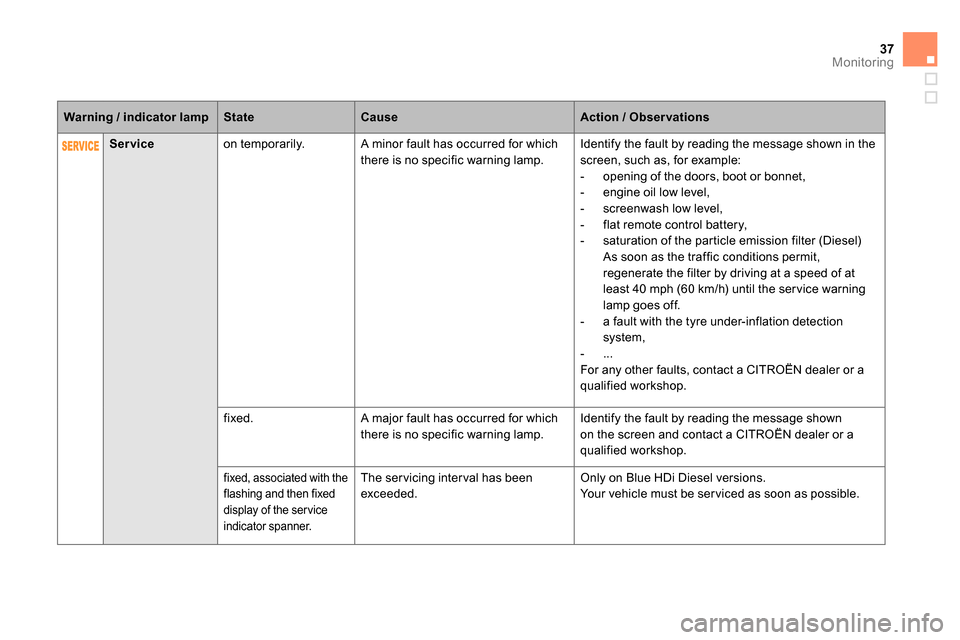
37Monitoring
Service
on temporarily. A minor fault has occurred for which
there is no specific warning lamp. Identify the fault by reading the message shown in the
screen, such as, for example:
- opening of the doors, boot or bonnet,
- engine oil low level,
- screenwash low level,
- flat remote control battery,
- saturation of the particle emission filter (Diesel)
As soon as the traffic conditions permit,
regenerate the filter by driving at a speed of at
least 40 mph (60 km/h) until the ser vice warning
lamp goes off.
- a fault with the tyre under-inflation detection
system,
- ...
For any other faults, contact a CITROËN dealer or a
qualified workshop.
fixed. A major fault has occurred for which
there is no specific warning lamp. Identify the fault by reading the message shown
on the screen and contact a CITROËN dealer or a
qualified workshop.
fixed, associated with the
flashing and then fixed
display of the ser vice
indicator spanner.
The ser vicing inter val has been
exceeded. Only on Blue HDi Diesel versions.
Your vehicle must be ser viced as soon as possible.
Warning / indicator lamp
State
Cause
Action / Observations
Page 47 of 372
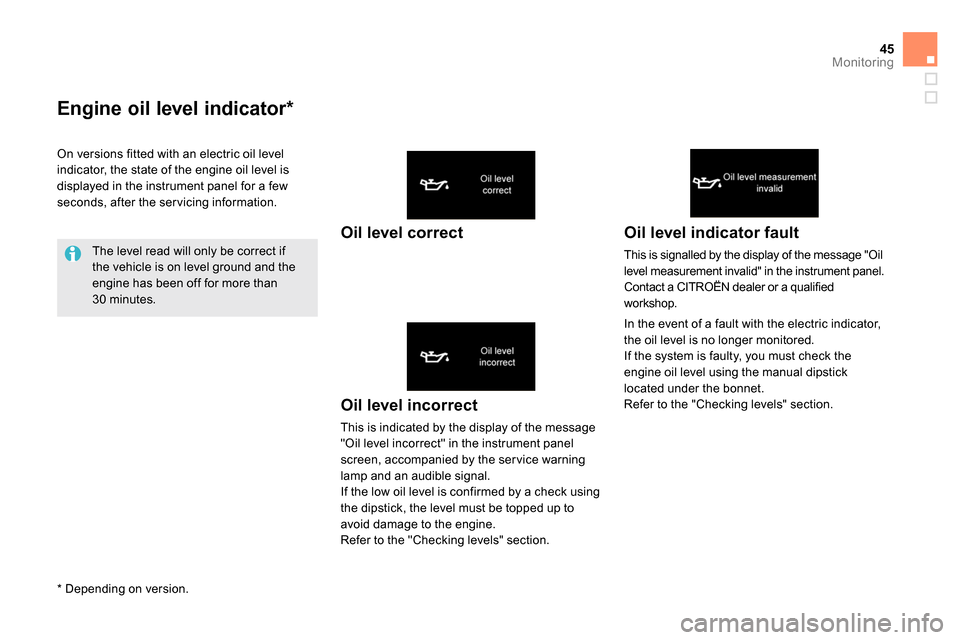
45Monitoring
Engine oil level indicator *
Oil level incorrect
This is indicated by the display of the message
"Oil level incorrect" in the instrument panel
screen, accompanied by the ser vice warning
lamp and an audible signal.
If the low oil level is confirmed by a check using
the dipstick, the level must be topped up to
avoid damage to the engine.
Refer to the "Checking levels" section.
Oil level indicator fault
This is signalled by the display of the message "Oil
level measurement invalid" in the instrument panel.
Contact a CITROËN dealer or a qualified
workshop.
In the event of a fault with the electric indicator,
the oil level is no longer monitored.
If the system is faulty, you must check the
engine oil level using the manual dipstick
located under the bonnet.
Refer to the "Checking levels" section.
On versions fitted with an electric oil level
indicator, the state of the engine oil level is
displayed in the instrument panel for a few
seconds, after the ser vicing information.
The level read will only be correct if
the vehicle is on level ground and the
engine has been off for more than
30 minutes.
Oil level correct
*
Depending on version.
Page 67 of 372
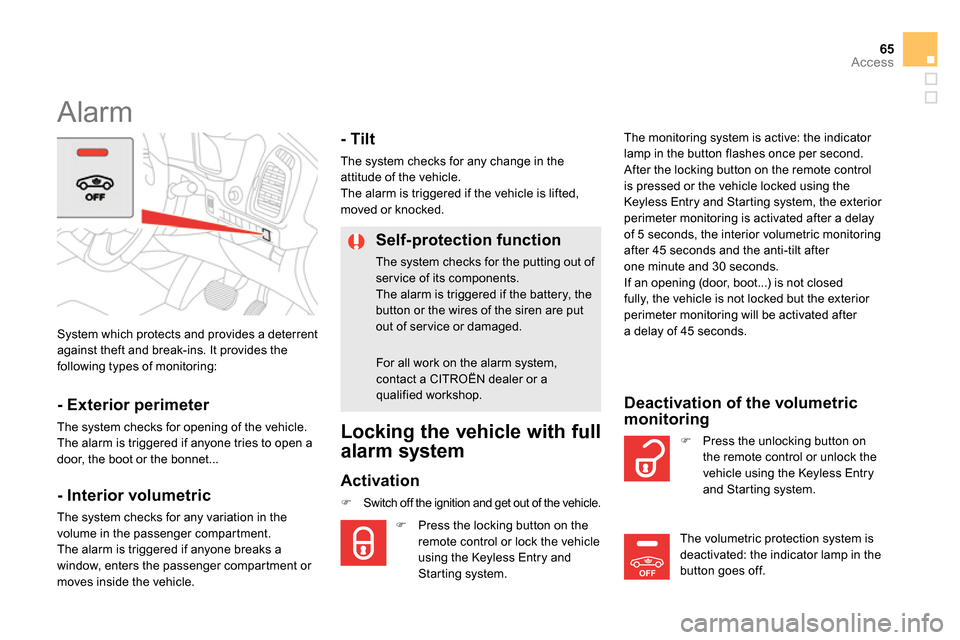
OFF
65Access
System which protects and provides a deterrent
against theft and break-ins. It provides the
following types of monitoring:
Alarm
- Exterior perimeter
The system checks for opening of the vehicle.
The alarm is triggered if anyone tries to open a
door, the boot or the bonnet...
- Interior volumetric
The system checks for any variation in the
volume in the passenger compartment.
The alarm is triggered if anyone breaks a
window, enters the passenger compartment or
moves inside the vehicle.
- Tilt
The system checks for any change in the
attitude of the vehicle.
The alarm is triggered if the vehicle is lifted,
moved or knocked.
Self-protection function
The system checks for the putting out of
ser vice of its components.
The alarm is triggered if the battery, the
button or the wires of the siren are put
out of service or damaged.
For all work on the alarm system,
contact a CITROËN dealer or a
qualified workshop.
Locking the vehicle with full
alarm system
Activation
Switch off the ignition and get out of the vehicle.
Press the locking button on the
remote control or lock the vehicle
using the Keyless Entry and
Starting system. The monitoring system is active: the indicator
lamp in the button flashes once per second.
After the locking button on the remote control
is pressed or the vehicle locked using the
Keyless Entry and Starting system, the exterior
perimeter monitoring is activated after a delay
of 5 seconds, the interior volumetric monitoring
after 45 seconds and the anti-tilt after
one minute and 30 seconds.
If an opening (door, boot...) is not closed
fully, the vehicle is not locked but the exterior
perimeter monitoring will be activated after
a delay of 45 seconds.
Press the unlocking button on
the remote control or unlock the
vehicle using the Keyless Entry
and Starting system.
Deactivation of the volumetric
monitoring
The volumetric protection system is
deactivated: the indicator lamp in the
button goes off.
Page 131 of 372

129Driving
The system is reactivated automatically
at every new start using the START/
STOP button.
Reactivation
Press the "ECO OFF"
switch again.
The system is active again; this is confirmed
by the switch warning lamp going off and a
message in the screen.
Operating fault
In the event of a fault with the system, the
"ECO OFF"
switch warning lamp flashes then
comes on continuously.
Have it checked by a CITROËN dealer or a
qualified workshop.
In the event of a fault in STOP mode, the vehicle
may stall.
All of the instrument panel warning lamps come
on.
Depending on version, an alert message may also
be displayed, asking you to place the gear lever in
position N
and put your foot on the brake pedal.
It is then necessary to switch off the ignition and
start the engine again using the "START/STOP"
button.
Before doing anything under the
bonnet, deactivate the Stop & Start
system to avoid any risk of injury
resulting from automatic operation of
START mode.
This system requires a 12 V battery with a
special specification and technology (reference
numbers available from CITROËN dealers).
Fitting a battery not listed by CITROËN
introduces the risk of malfunction of the
system.
For charging, use a 12 V charger and do not
reverse the polarity.
Maintenance
The Stop & Start system makes use of
advanced technology. For any work on
the system go to a qualified workshop
with the skills and equipment required,
which a CITROËN dealer is able to
provide.
Page 224 of 372

12 V battery
The presence of this label, in particular
with the Stop & Start system, indicates
the use of a 12 V lead-acid battery with
special technology and specification;
the involvement of a CITROËN dealer
or a qualified workshop is essential
when replacing or disconnecting the
battery. The battery is located under the bonnet.
To gain access to it:
open the bonnet using the interior release
lever, then the exterior safety catch,
remove the plastic cover on
the (+) terminal,
if necessary, unclip the fusebox to remove
the battery.
Access to the battery
Disconnecting the (+) cable
Raise the locking tab D
fully to release the
cable terminal clamp E
.
Reconnecting the (+) cable
Position the open clamp E
of the cable on
the positive post (+) of the battery.
Press vertically on the clamp E
to position
it correctly on the battery.
Lock the clamp by spreading the
positioning lug and then lowering the tab D
.
Do not apply excessive force on the
tab as locking will not be possible if the
clamp is not positioned correctly; start
the procedure again.
Procedure for starting the engine using another battery or charging a discharged battery.
Page 239 of 372
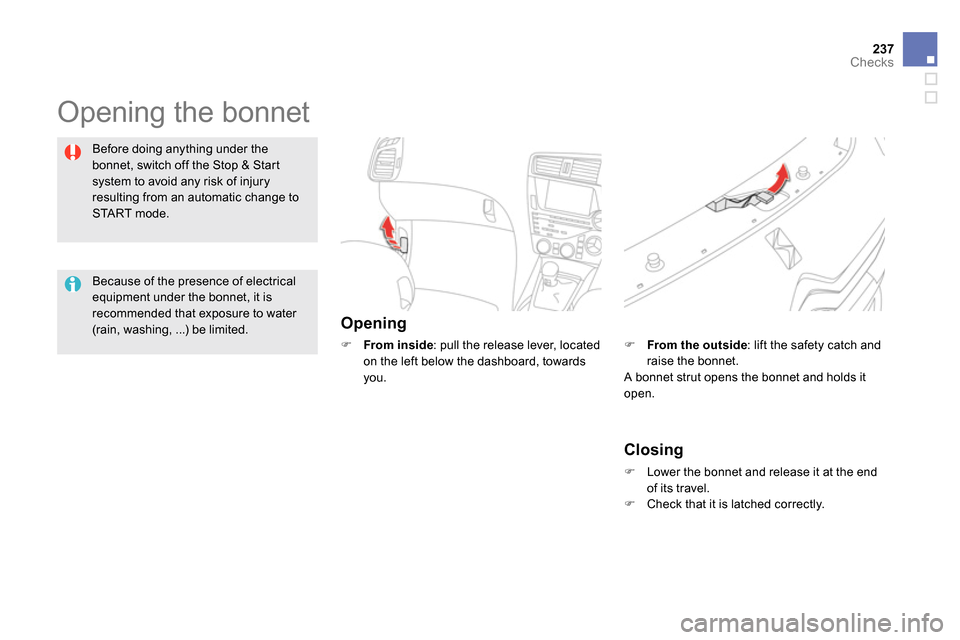
237Checks
Opening the bonnet
Opening
From inside
: pull the release lever, located
on the left below the dashboard, towards
you.
Before doing anything under the
bonnet, switch off the Stop & Start
system to avoid any risk of injury
resulting from an automatic change to
START mode.
Closing
Lower the bonnet and release it at the end
of its travel.
Check that it is latched correctly.
From the outside
: lift the safety catch and
raise the bonnet.
A bonnet strut opens the bonnet and holds it
open.
Because of the presence of electrical
equipment under the bonnet, it is
recommended that exposure to water
(rain, washing, ...) be limited.
Page 242 of 372

On vehicle fitted with HDi engines, the fuel
system must be primed if you run out of fuel;
refer to the corresponding engine compartment
view.
Running out of fuel (Diesel)
If the tank on your vehicle is fitted with
a misfuel prevention device, refer to the
"Misfuel prevention (Diesel)" section.
Fill the fuel tank with at least five litres
of diesel.
Open the bonnet.
If necessary, unclip the styling cover for
access to the priming pump.
Squeeze and release the priming pump
repeatedly until resistance is felt (there
may be resistance at the first press).
Operate the starter until the engine starts
(if the engine does not start at the first
attempt, wait around 15 seconds before
trying again).
If the engine does not start after a few
attempts, operate the priming pump again
then start the engine.
Clip the styling cover back in place.
Close the bonnet.
1.6 litre HDi engine
Fill the fuel tank with at least five litres of
Diesel.
Open the bonnet.
If necessary, unclip the style cover for
access to the priming pump.
Slacken the bleed screw.
Squeeze and release the priming pump
repeatedly until fuel appears in the
transparent pipe.
Tighten the bleed screw.
Operate the starter until the engine starts
(if the engine fails to start at the first
attempt, wait around 15 seconds before
trying again).
If the engine fails to start after a few
attempts, operate the priming pump again,
then the starter.
Put the style cover back in position and
clip it in place, ensuring that it has clipped
correctly.
Close the bonnet.
2 litre HDi engine
If the engine does not start first time,
don't keep trying but start the procedure
again from the beginning.